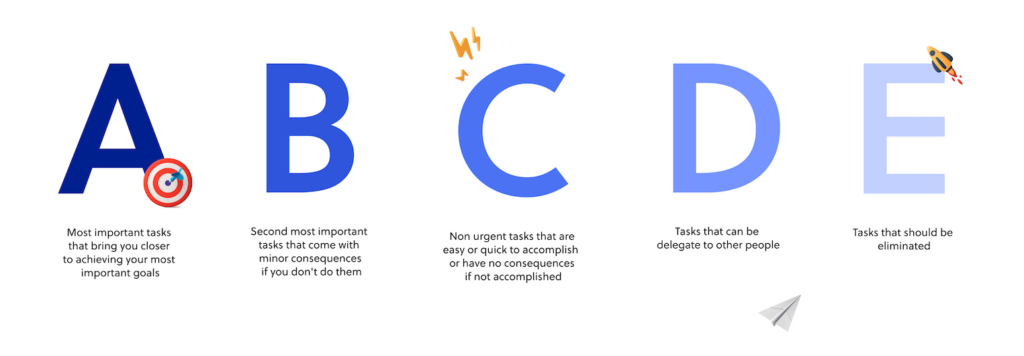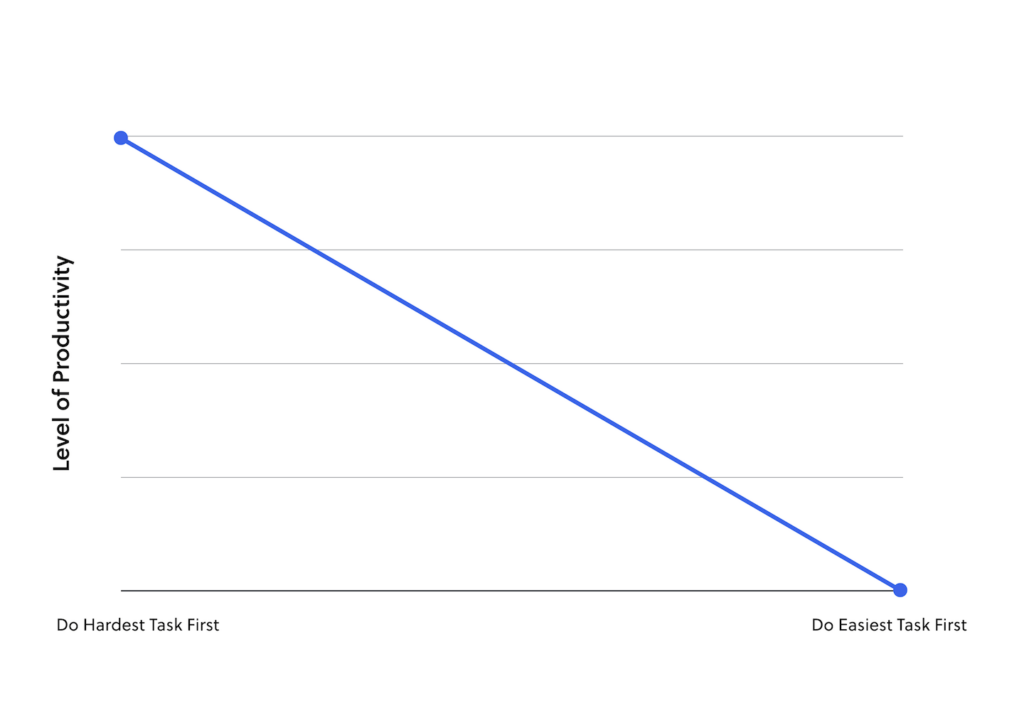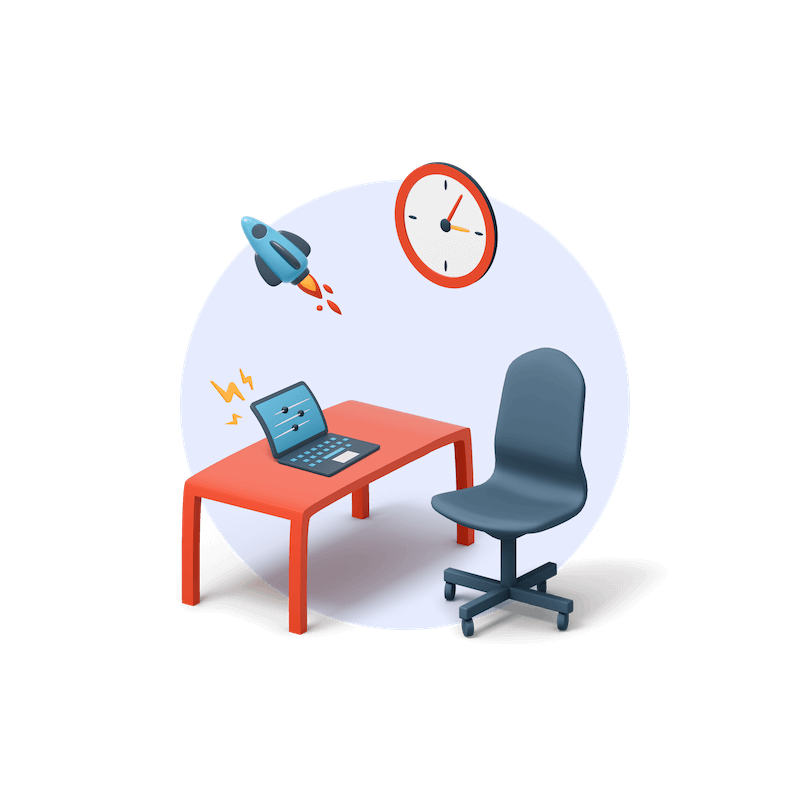To-do lists are an essential part of beating work overload. Keeping a well-structured and thought-out list sounds pretty simple. But that just isn’t enough. Here’s why.
A to-do list doesn’t usually tell you how important each of your tasks is. We tend to feel much more resistant about working on challenging tasks even though those are the ones that potentially can bring more value.
When you write off most of the tasks, you may feel as if you’ve done a pretty good job. Your day will seem productive and successful. This thinking can be deceiving.
Signing off most tasks may not be enough, especially if they turn out to be low-priority ones while the critical tasks are left undone. So, what seems like feeling good about yourself is a false sense of productivity. And from there, there is a straight road to sabotaging your success.
This is where you need a technique to prioritize your list. The ABCDE Method is one of them.
Let’s learn more about what the ABCDE technique is, where it originated from, and how it works.
Table of Contents
What is the ABCDE Method?
The ABCDE concept is a priority-setting technique invented by productivity expert Brian Tracy. Brian Tracy is a Canadian-American motivational public speaker and author of more than 60 books and over 500 audio and video learning programs. His publications are focused on management, sales, business success, and personal development.
Tracy’s order of importance strategy helps to beat poor time management effects while setting priorities for all the tasks. The method is fairly simple and requires no special training.
All you need is to understand the level of importance of each task. Each task will have a letter assigned based on how important it is.
According to Tracy, your “ABCDE list is a to-do list on steroids,” showing you how to prioritize.
The success of this technique lies in its simplicity. It’s simply action-oriented.
The aim of the method is that your energy becomes focused. The idea is to make you feel more competent in your abilities. If you add discipline and hard work factors, you’ll be on your way to success.
In the ABCDE Method, your focus starts with deciding to start and complete the first task on your list, the A-1 task.
Learning to prioritize is one thing, but you will need some willpower to keep you going. The good news is recent studies revealed that anyone could strengthen willpower through training.
But, the more thought you put into setting priorities before you begin working on the tasks, the faster you will get the critical tasks done. And the more valuable and critical the task is to you, the more motivated you will be to overcome procrastination and get things done.
Now, let’s dive into the benefits of the ABCDE technique.
Benefits of the ABCDE Method
The ABCDE Prioritization Method is a powerful priority-setting technique based on a regular to-do list. The task list becomes much more organized and even more constructive. Tracy’s method helps to identify the activities that lead to success and the tasks that are nothing more than distractions.
If you’re wondering who the ABCDE Method works for best, the answer is simple. It works for everyone. Anyone can use the method every single day. But it’s especially helpful when used for your everyday tasks at work. Here’s why.
People around you will see you as unfocused and unreliable when you don’t use your task list effectively. As a result, you might be seen as a “spuddler.” A spuddler is someone who is working slowly or inefficiently to achieve nothing while feeling like they are ‘busy.’
When you do complete your tasks effectively, you’ll appear better organized and reliable.
Your everyday life will seem less stressful, assured that you haven’t forgotten anything important.
Intelligent prioritization will help you focus your time and energy on high-value tasks. That way, you’ll become an efficient and valuable team member of your company.
Now you’ve learned what Tracy’s method is and its benefits, let’s see how you can use it.
How To Use the ABCDE Method
The concept behind the technique is assigning A, B, C, D, and E letters to tasks, depending on their priority. The below image illustrates the rules briefly:

Let’s go over the core rules for classifying and marking tasks using the ABCDE Method.
‘A’ Tasks Are the Most Important Tasks
The highest priority tasks should get assigned the letter ‘A.’
Your A-tasks are the jobs that you must do. They are too important to ignore, and if you do ignore them, there will be serious consequences. At the same time, they are likely to have the biggest upsides once accomplished.
For example, an example of an A-task could be finishing an important report for your boss that’s needed for an upcoming board meeting, speaking with a key stakeholder, or signing off a project phase so that it can be moved to the next one.
In Tracy’s 2001 book, Eat That Frog!: 21 Great Ways to Stop Procrastinating and Get More Done in Less Time, he compares your most important activity to eating a frog. This came from Mark Twain’s quote: “Eat a live frog first thing in the morning, and nothing worse will happen to you the rest of the day.”
In other words, you should tackle the hardest and most important thing on your to-do list first. For Tracy, and his ABCDE Method, a ‘frog’ is not just an activity people tend to avoid; it’s going to have the biggest positive impact on your work life.
You may find that more than one task should fall into the A-task list. In such cases, you should sub-rank them with a numerical suffix—for example, A-1, A-2, A-3.
Consider your A-1 task the most important, followed by A-2 and A-3.
However, for best time management results, you should aim to have only one activity in the ‘A’ category. If you feel you need to have more, don’t go over the maximum of three. Otherwise, you may end up with a very long list of the A-tasks, which takes you back to square one—being stuck with just a regular, chaotic to-do list.
👉 Worth reading: Most Popular Time Management Techniques
‘B’ Tasks Have Minor Consequences
According to the ABCDE Method, the activities on your list that are also necessary but don’t have critical consequences should be marked as B-tasks.
Look out for important tasks with no upcoming deadline. Ones where failing to do them won’t do as much harm. This means that someone may not be happy if you don’t do it, but it’s nowhere as important as an A-task.
Examples of activities that can fall into this category are returning unimportant calls and emails.
Your B-tasks should be considered as tasks that should be done, but never before completing all of your A-tasks.
‘C’ Tasks With No Consequences
A C-task is an activity that would be nice to do, but whether you do it or not, there will be no consequences at all.These ‘nice to do’ tasks are usually the ones you enjoy doing, and without a priority list, you tend to head over to and complete them first. But, as the below graph illustrates, completing the easiest tasks first is less productive.

In the ABCDE Method, quick and easy-to-accomplish C-tasks usually don’t contribute much towards your goals.
Good examples of not important tasks from your C-list are having lunch with a coworker, phoning a colleague, and going over personal business during work hours. Notice that these activities do not affect your work life.
Needless to say, you should never start a C task when you have unfinished B or A tasks.
‘D’ Tasks You Should Delegate
You should label a task with a D status if it can be delegated to other people.
Tracy believes that you should delegate to someone else everything that you possibly can. This strategy frees up time that you can spend on engaging with the A-activities. This is important, as ultimately, the A-tasks and their completion have the biggest impact on your career.
You may think that delegating tasks is being lazy and trying to get rid of the tasks. Think again.
In the ABCDE Method, delegating tasks means making wise decisions within task management and helps to build trust between you and your team members. This is critical for business, as trust is an essential ingredient to a team’s success.
Delegating jobs to others can have an additional ‘side effect’.
According to the Pygmalion Effect, if you expect someone to succeed based on your judgment of their abilities, they do. So, if you identify talented employees, set expectations for them, and give them opportunities relevant to their skills and potential, they will do well in those jobs.
Therefore, delegating even strategic tasks can help you build a productive team of skilled employees. At the same time, it helps you focus on tasks that make a difference in your progress.
‘E’ For Eliminate
The last category gets the E index. Any job that doesn’t fit the criteria for A, B, C, or D should be marked as an E-task and eliminated from your list.
That means E-tasks are considered irrelevant. Eliminating irrelevant tasks is necessary to get your time under control. If something is no longer necessary for you to do, you should stop doing it.
This could, for example, be printing 30-page meeting minutes if you can access and read them on screen.
Useful ABCDE Method Implementation Tips
Let’s go over some useful tips for the implementation of the ABCDE technique:
- Decide on the specific timeframe. Do you need your list to determine your daily, weekly, or monthly tasks? This should be done before you put together a to-do list.
- To make the most out of the ABCDE Method, you should commit yourself to jump on the A-1 task first each time. Discipline yourself to stay at it until it’s complete. After all, this A-task may be the single most important task you could be doing.
- Avoid distractions, especially when working on your A-tasks. According to a study from the University of California Irvine, it takes 23 minutes and 15 seconds on average to get back to the task after a distraction.
- Assess every new task or project that comes up. Enter the task in your list and designate an A to E status. This should be done before you start working on it.
- Don’t work on anything that isn’t on the list. Otherwise, you may get caught up in low-value activities, leading to losing control of your time.
The above tips will give you a proactive working style. You’ll regain control over your task list and overall work life. No longer will you be constantly reacting to the demands of others.
ABCDE Method Example
A project manager deals with competing priorities every day. Although they can use a project management tool to identify priorities, essentially, it’s the discretion of the manager to determine what a priority is and what is not.
Say you are a project manager with 1,001 things to do, including effective resource management and project cost management. You start to feel overwhelmed by the number of things you need to get done. Every task feels important. Your success depends on deciding what tasks you choose to do and what you leave out.
So, how does the ABCDE Method work in this case? You could, for example, implement it as follows.
First, write down everything that needs to be done tomorrow.
The next step is to prioritize. Place an A, B, C, D, or E next to each task. Your list could look like this:
A-1 finish a report your superior needs for an upcoming meeting
A-2 meet a key supplier
At this point, remember not to start on a B task until all the As are completed.
B-1 check and reply to your emails
B-2 return a call to the HR department
B-3 do an employee one-year performance appraisal
Similarly to the above, don’t start on C-tasks until all the As and Bs are cleared.
C-1 update your social media accounts
C-2 call a friend during work hours
C-3 get a daily update on the news
D-1 write copy for a new product manual instruction leaflet. Even though you feel you would do it better and quicker–delegate such tasks following the ABCDE Method. It will come to you for checking anyway, so you’ll have a chance to suggest changes.
D-2 book a flight and hotel for your business trip. Surely someone else can do it for you, or at least research the options so that you can make the final call.
D-3 pitch a new product launch presentation. Appoint someone from your team to do it. After all, they should know all the product details as well as you do.
E-1 update spreadsheets that were once used to make key decisions. Eliminate things like that to free up space for what’s important.
Now your to-do list is prioritized, you can gain clarity on what’s important and what can be eliminated. As a project manager, you will be able to optimize your productive time management so that every minute brings you closer to your career goal.
Eat Your Frog
Practicing Brian Tracy’s Method daily, and on every project list will help you start doing more than the people around you.
Set priorities using the ABCDE method before you begin work and commit yourself to follow the rules. Soon, you will develop the habit of setting and working on your highest-priority tasks. The tasks that matter to your progress and career. They may prove challenging, like eating your frog, but they’ll make the biggest difference.
Go on and review your work list right now. Put an A, B, C, D, or E next to each task, and make sure you follow the above tips for great time management.







